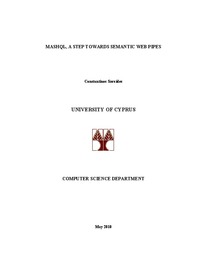MASHQL, A step towards semantic web pipes

View/
Date
2010-05Author
Savvides, ConstantinosPublisher
Πανεπιστήμιο Κύπρου, Σχολή Θετικών και Εφαρμοσμένων Επιστημών / University of Cyprus, Faculty of Pure and Applied SciencesPlace of publication
CyprusGoogle Scholar check
Metadata
Show full item recordAbstract
This thesis is motivated by the massively increasing structured data on the Web, and the need for novel methods to exploit these data to their full potential. Building on the remarkable success of Web 2.0 mash-ups, and especially Yahoo! Pipes, we represent a design and implementation of a server-side interactive query formulation language, MashQL [17], which allows people to navigate, query, and mash-up a data source(s) without any prior
knowledge about its schema, vocabulary, or technical details. Assuming the Internet data is represented in RDF, we can query by using SPARQL which is the recent recommendation by the W3C. Furthermore, Oracle 11g semantic technology supports an efficient way for RDF storage and query in a SPARQL-like style. We also present the technologies that we have use in our implementation and how they are related to it.
In addition we present the design issues that we have to consider, so that we could achieve a nice user-friendly environment for our users. The user interface is inspired from the interface that Yahoo Pipes has, because of its simplicity to formulate pipes in a visual way.
We also refer to the system and software architecture that we have follow, in order to develop a successful web application.
We also evaluate the usability of the editor and obtain the first impressions and comments from our participants, about using this unfamiliar technology, by completing some scenarios. By evaluating these scenarios, we will understand the potentials of our editor and also know where we can modify and evolve our editor in a future version. Also we evaluate the time-cost of formulating a MashQL query and time-cost of loading RDF sources into oracle’s semantic technology, and present the limits of our implementation.
